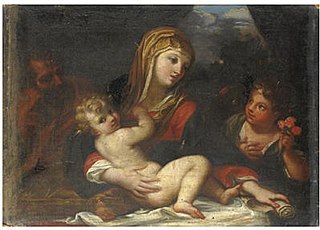

Ludovico Seitz, or Ludwig Seitz (11 June 1844, Rome - 11 September 1908, Albano Laziale) was an Italian painter of German ancestry, who served as Director of the Vatican Galleries.


Ludovico Seitz, or Ludwig Seitz (11 June 1844, Rome - 11 September 1908, Albano Laziale) was an Italian painter of German ancestry, who served as Director of the Vatican Galleries.
His father was the painter, Alexander Maximilian Seitz, a member of the Nazarene movement; originally from Munich. His mother, Gertrud née Platner, was the daughter of the painter and diplomat, Ernst Zacharias Platner. [1] King Ludwig I was his godfather. [2]
He initially studied art with his father, then with Friedrich Overbeck and, later, from Peter von Cornelius. In 1887, he became an Inspector (curator) at the Vatican Galleries, and was promoted to Director in 1894. He belonged to several Catholic artists' associations and produced numerous religious frescoes, mostly in Nazarene style, but also with hints of Historicism.
Perhaps his best known works are ceiling frescoes, commissioned by Pope Leo XIII, in the "Gallery of Candelabras" at the Apostolic Palace, which is now a part of the Vatican Museums. He also created paintings at Sant'Ivo dei Bretoni, a French church, and the chapel at the Basilica della Santa Casa. Together with his father, he painted murals at Đakovo Cathedral in Croatia. [3]
Santa Maria dell’Anima, the German national church, has works by Seitz in the chapel dedicated to saints John of Nepomuk and Jan Sarkander, as well in the ceiling of the nave.
His students included the Bavarian church painter, Kaspar Schleibner, and the Belgian artist, Jozef Janssens, who also created religious works. His successor at the Galleries was the Italian painter and art historian, Pietro D’Achiardi.

Philipp Veit was a German Romantic painter and one of the main exponents of the Nazarene movement. It is to Veit that the credit of having been the first to revive the nearly forgotten technique of fresco painting is due.

Anton Raphael Mengs was a German painter, active in Dresden, Rome, and Madrid, who while painting in the Rococo period of the mid-18th century became one of the precursors to Neoclassical painting, which replaced Rococo as the dominant painting style in Europe.

Masolino da Panicale was an Italian painter. His best known works are probably his collaborations with Masaccio: Madonna with Child and St. Anne (1424) and the frescoes in the Brancacci Chapel (1424–1428).

Julius Schnorr von Carolsfeld was a German painter, chiefly of Biblical subjects. As a young man he associated with the painters of the Nazarene movement who revived the florid Renaissance style in religious art. He is remembered for his extensive Picture Bible, and his designs for stained glass windows in cathedrals.

The epithet Nazarene was adopted by a group of early 19th-century German Romantic painters who aimed to revive spirituality in art. The name Nazarene came from a term of derision used against them for their affectation of a biblical manner of clothing and hair style.

Johann Friedrich Overbeck was a German painter and a founder of the Nazarene art movement.

Corrado Giaquinto was an Italian Rococo painter.

Franz Pforr was a painter of the German Nazarene movement.

Palazzo dei Diamanti is a Renaissance palace located on Corso Ercole I d'Este 21 in Ferrara, region of Emilia Romagna, Italy. The main floor of the Palace houses the Pinacoteca Nazionale di Ferrara.

Giacinto Calandrucci was an Italian painter of the Baroque period.

Alexander Maximilian Seitz (1811-1888) was a German painter and a leader of the Nazarene movement.

Ernst Zacharias Platner was a German painter, writer, and diplomat.

The Alter Südfriedhof also known as "Alter Südlicher Friedhof" is a cemetery in Munich, Germany. It was founded by Duke Albrecht V as a plague cemetery in 1563 about half a kilometer south of the Sendlinger Gate between Thalkirchner and Pestalozzistraße.

The Đakovo Cathedral or Cathedral basilica of St. Peter is the cathedral of the Roman Catholic Archdiocese of Đakovo-Osijek in Đakovo, Croatia.

The Church of Saint Ivo of the Bretons is a Roman Catholic church dedicated to Saint Ivo of Kermartin, patron of Brittany. It is one of the national churches in Rome dedicated to Brittany.

The Church of San Pellegrino in Vaticano is an ancient Roman Catholic oratory in the Vatican City, located on the Via dei Pellegrini. The church is dedicated to Saint Peregrine of Auxerre, a Roman priest appointed by Pope Sixtus II who had suffered martyrdom in Gaul in the third century. It is one of the oldest churches in the Vatican City.

Carl Johann Adolf Eggers was a German history painter.

Johann Nepomuk Schaller was an Austrian sculptor. His most famous work is a bust of Ludwig van Beethoven at age 55, created at the request of the composer's secretary Karl Holz in 1825. It was later presented to the Royal Philharmonic Society, London, on the occasion of the Beethoven Centennial.

Kaspar Schleibner was a German church painter.

Rudolf (von) Seitz was a German painter, illustrator, and designer.